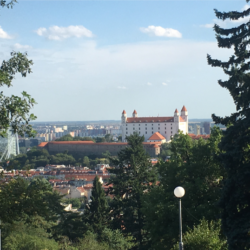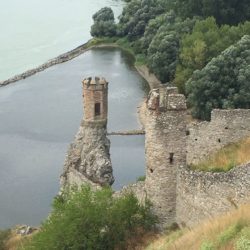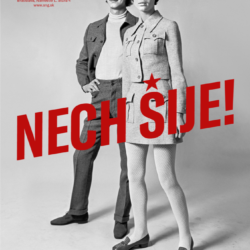
Bratislava’s Staré Mesto (Old Town) is the compact and easily-walkable heart of the city. Some of the buildings in this district were constructed as far back as the 13th (Town Hall) and 14th (Michael’s Gate) Centuries, although many of the palaces and theaters date from the days of the Habsburgs, and later Austro-Hungarian rule.
First, a little history primer may be necessary to truly appreciate the area:
For over 1000 years (907-1918 AD), Slovakia was part of the Hungary in one form or another, first as part of the Kingdom of Hungary and later under joint control with the Habsburgs until the Austro-Hungarian Empire’s dissolution in 1918. Bratislava was heavily favored by Queen Maria Theresa and between 1563-1830, 19 Hungarian kings and queens were crowned in the city. After World War I, the Czechs and Slovaks joined together to form Czechoslovakia which last until 1939, when Slovakia was overtaken by Hitler and Nazi Germany. Between 1939-1945 Bratislava became the capital of the First Slovak Republic, but this republic existed in name only as in reality it was a satellite state of Nazi Germany. In this dark period, 70,000 Slovak Jews were deported, with an estimated 65,000 killed in concentration camps. (The Jewish Community Museum and Synagogue is easily the most moving in all of Bratislava and a must-visit. http://www.synagogue.sk) After the Soviet army liberated Bratislava from Nazi control in 1945, Czechoslovakia was re-established and then promptly placed under Stalin’s control in 1948. The Velvet Revolution in 1989 saw the end of communism in Czechoslovakia and in 1993 the Czech Republic and Slovakia split to form the two nations they are today.
As painful as some of this history is, it has created a swirl of medieval, Austro-Hungarian, Soviet and modern architecture in Bratislava that somehow all works together and adds to the character of the city.
Without further ado, here is the best of the Staré Mesto:

Micheal’s Gate was part of the original city walls and completed in the 14th Century when Bratislava was known as Pressburg. The five floors inside hold the Museum of Arms, which I honestly breezed through, but entry was still worth it as the views from the top of the tower were fantastic. The breeze alone would have satisfied me, providing a respite from the warm streets below.


Visible from the top of Michael’s Gate is the Old Town Hall, which is right on the Hlavné námestie (Main Square). City history museums can sometimes be a little dry, but most make up for it by giving you a better understanding of what you’re walking around and looking at. Bratislava’s City Museum is no different. It might not be setting the world on fire, but it’s a decent way to pass 45 minutes learning about the city- plus you are able to climb another tower for views of the Hlavné námestie.

In the background you can see Dóm sv. Martina (St. Martin’s Cathedral) and another view of the castle. St. Martin’s was where the coronations of the 19 Kings and Queens of Hungary took place between 1563-1830. It, along with the castle, are the most visible and famous sites in the Staré Mesto.


This historic theater, built in 1886, still puts on theater, ballet and opera productions with the Slovak National Theater, even after the New building of the National Theater opened in 2007. The theater is at the end of the most peaceful pedestrian zone in the city. I’ll admit to stopping for ice cream once or twice or, well the number’s not really important here. What matters is the tree-lined street with fountains and multiple ice cream shops!



The Primate’s pretty-in-pink palace was completed in 1781 and several rooms are open to the public, including the Hall of Mirrors. My visit was brief and if you’re crunched for time the most impressive feature truly is the pink exterior.

Not to be outdone by the pink Primate’s palace, the Blue Church is one of the more unique little churches I’ve come across. The church is one of the newer buildings on my list, dating from 1913. Despite the opening hours I could find online, the church was closed both times I attempted to go inside, but despite its location outside of the central pedestrian zone, the Blue Church could well be the highlight of the Staré Mesto.


